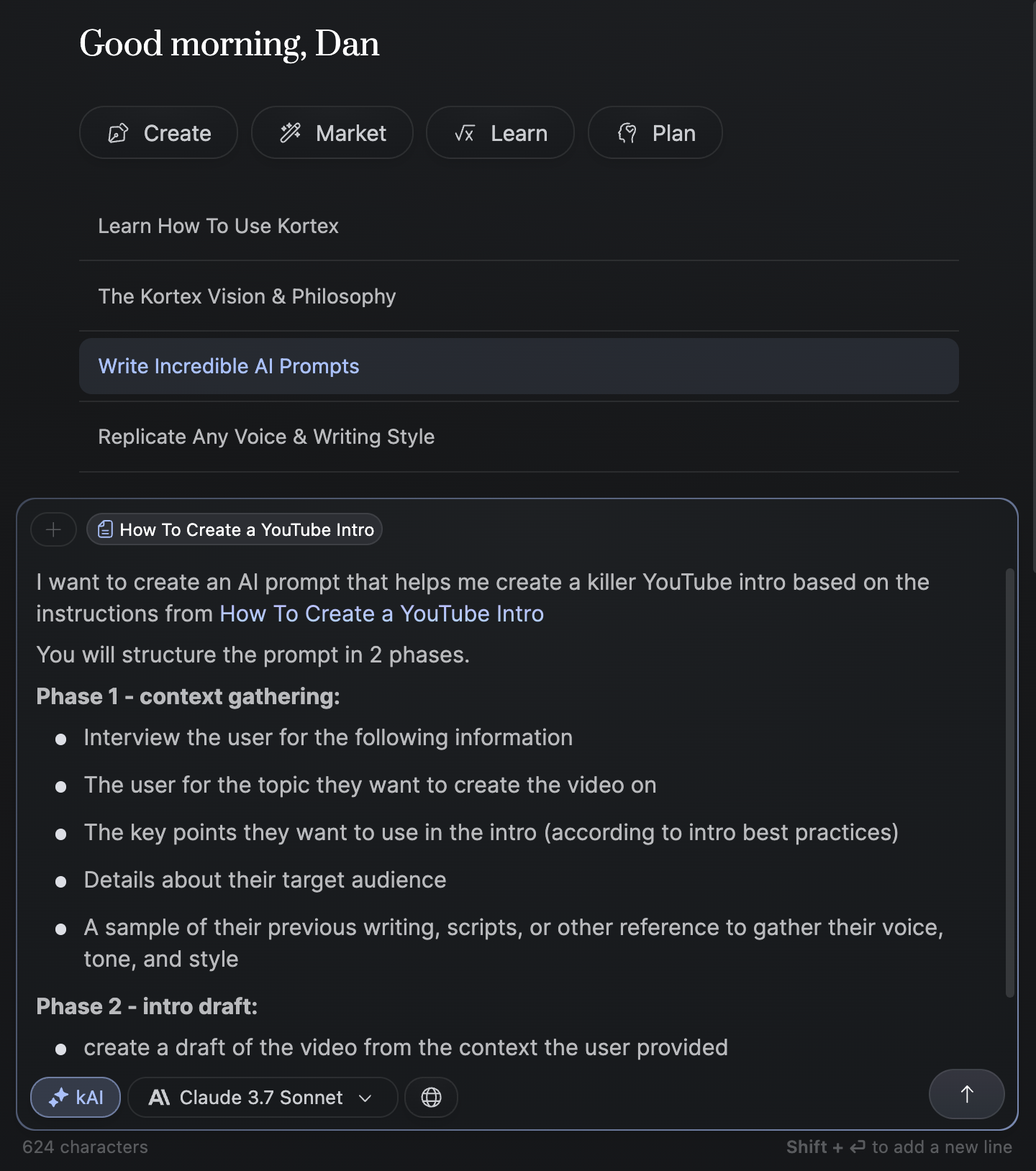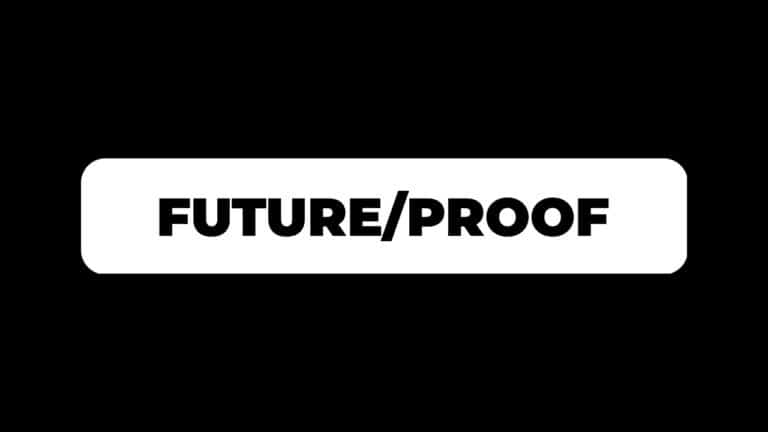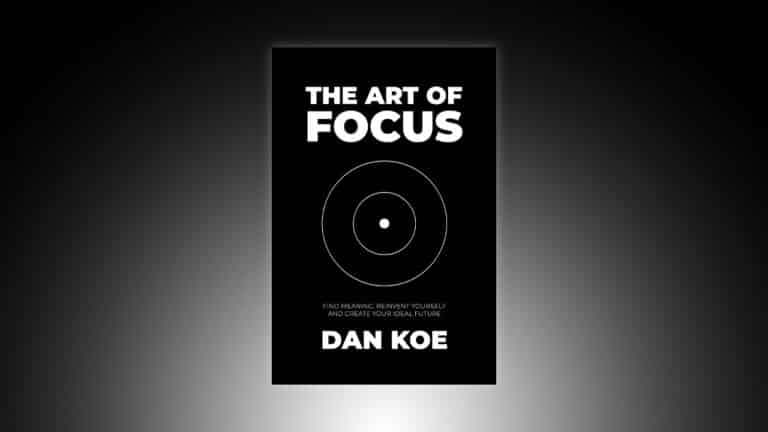Right now, creators mostly sell digital products and services.
Coaching, courses, communities, cohorts, and subscription memberships.
And it makes sense.
They have huge profit margins. They can be fulfilled at scale by one person. They provide more freedom than relying on platform revenue or accepting sponsorships. And they are arguably the most transformative type of product someone can buy – there’s never been a time where affordable interest-based education from people on the cutting edge of skills have been available, and since education influences behavior, proper education is the only thing that can change your life. Of course, there are bad actors.
Now, I have a prediction for how this will evolve.
If you understand this, you may be able to gain a competitive advantage over the next few years.
I’m basing it on these beliefs:
1) Information will never be free
On the one hand you have—the point you’re making, Woz—is that information sort of wants to be expensive because it is so valuable—the right information in the right place just changes your life. On the other hand, information almost wants to be free because the costs of getting it out is getting lower and lower all of the time. So you have these two things fighting against each other.
– Stewart Brand interviewing Apple’s Steve Wozniak
Information doesn’t want to be free because information doesn’t want.
People want information to be free because they don’t understand that information is labor.
And while it may sound cliche at this point, if people don’t pay, they don’t pay attention. Only those with a poor relationship with money have a problem paying for critical information.
Of course, information becomes less valuable the longer it is around. It becomes common knowledge, AI becomes trained on the most popular or relevant, but there is still another category that will retain its value into the near future.
That’s where creators come in.
Creators deal in personal information (writing, audio, video) and will continue to.
The problem is getting the right information in the right place, as Brand points out to Wozniak in the quote above.
2) AI will never give you the best answer out of the box
It’s not that AI isn’t as good as you.
It’s that you aren’t good enough to make AI better than you.
Because if you ask ChatGPT to write you a book, it will, but it won’t be worth reading.
If you are both skilled in writing a book and in prompt engineering (giving clear instructions to AI, mostly) then you can probably write an incredible book much faster than you were able to before, and it would still be from your knowledge, not the AIs.
AI is only effective in highly relative domains (like marketing, writing, design, or anything non-mechanical) when it has a sufficient amount of context. So much so that it is no longer the AI providing the knowledge as it is doing the busy work.
This will make sense.
3) Courses are static
There are 3 types of offers.
Do it yourself. Done with you. Done for you.
These are what creators have sold since the dawn of social media. Some freelance with skills like marketing. Some coach with interests like health. Some sell courses if they want a low-ticket product in the mix.
But each of those have their downsides.
Courses are static information that must be interpreted correctly in order to work.
Freelancing is usually unfulfilling because you’re working on others projects rather than your own.
Coaching requires either a lot of time or a growing team if you want to scale.
But what if AI now allows you to collapse all of them into one?
What if a digital product provided both the education and the execution based on your own unique knowledge?
The Future Of Digital Products
I’ve created a few digital products in my time.
My next one is going to be a 30 day challenge to build a personal brand.
(Because I want to test this theory before we try to catch the wave by building it as a feature into Kortex – sharing workspaces with custom prompts).
Now, let’s run through a scenario.
Imagine that I have 2 pieces of the digital product:
- The education – the curriculum or knowledge laid out in an easy to digest way.
- The execution – AI prompts built from that specific knowledge to allow you to execute faster.
Neither of those are as valuable alone as they are together.
Having AI do the task for you doesn’t teach you how to do the task yourself, so when the AI inevitably only gives you a first draft, you don’t know how to create a final draft that works. AI doesn’t solve for iteration or lack of results (unless you know where to guide the AI).
This is why “vibe coders” can’t build anything complex right now.
They don’t understand coding at a high-level, so when they hit a bug, they either have to start learning to code, or they get stuck because they outsourced their agency. Even when people can code an entire app in natural language, that doesn’t mean people will use it. In other words, you still need to learn.
And when you only have the education, it’s difficult to apply that knowledge to your own situation. Many people struggle with courses because they try to copy the teacher without realizing that their unique situation changes how that education is applied.
This is where the combination of both thrive.
AI is great at collecting your personal context, especially when prompted to, so that it can perform the task with that taken into account.
If you were learning from me to start a personal brand, there are a lot of moving variables. You have to extract your beliefs, opinions, interests, ideas, and the rest. AI can’t pull that out of your mind, but it can help guide your mind to coming up with those things.
This is why courses have such a low completion and success rate.
Let me make this more clear:
Imagine a YouTube course.
It teaches:
- How to generate ideas that have viral potential
- How to design and iterate on thumbnail ideas
- How to outline the YouTube script and key points
- How to format the hook and introduction to reduce drop off
- How to storyboard the video for pacing, b-roll, main shots, and visuals
What you need to understand is that there is no best way to do this.
If you ask AI to do these things without context, it will give you general information it can find on the internet.
But the thing about YouTube, and most relative (non-mechanical) domains, is that “what works” changes quite often. No YouTuber is the same as another, yet they all seem to reach some form of success. That means that even a YouTube specific AI software will have it’s faults because it will probably be built off of one best practice. If everyone uses that AI tool, it generates less results.
So, for this YouTube course, the creator builds it out with their own mind, model, and methods.
Then, when they turn each of the bullet points above into a prompt (like idea generation, outline, scripting, etc), something magical happens.
Not only do you have education, you have execution!
Do you realize how insane that is?
A YouTube course is no longer a course. It’s a piece of the creators mind that can act on its own.
You, as an individual, can purchase this piece of their mind, study the “operating manual,” give it your own context, and then it does the work for you.
It gives you ideas, you choose one, it guides you through the outline, you edit it, it spits out a script according to your own voice, and hell, at some point it AI will be able to create the entire video while sounding like you and looking like your style.
It’s still you creating the video, you’re just doing less work.
This isn’t AI slop because it has context.
If you want to see this in action, watch this video I made on the Kortex channel.
What about a content team for a company? You don’t need to hire the person as a freelancer, because they can do the work for you without being there.
What about something like fitness coaching? Where they can’t do the work for you? Well, they can still have prompts that create customized training programs, nutrition protocols, and daily check ins to track your progress, weight loss, or whatever it may be.
You’re no longer selling a course.
You’re selling a complete solution – a personal and specific system that AI will never give you out of the box, because it needs to be trained to do so – that is much more likely to get results.
The value of information isn’t going down, it’s increasing sharply.
How To Build An AI First Product
If you’re a creator, or you want to be a creator, the best thing you can do is learn how to turn your knowledge into a prompt.
If you’re a beginner and do this well, congratulations, you now have your first product that you can start selling immediately!
Here’s exactly what I would do:
1) Document Your Process
Open up a note or document to write in.
If you want to make this easier on you, do this in Kortex so you can reference that document in an AI chat when we turn this into a prompt. You can copy and paste between something like ChatGPT, but Kortex has ChatGPT models and all other models, so you can pick different ones for different use cases.
From there, act as if you are giving detailed instructions to someone else so they can do what you do.
This will take some time.
If you are a YouTuber, then you need to create a document for each step of your process. Look at the bullet points from before and expand on each of those.
For creating a YouTube intro, it could look like this (linked in a document because it’s long and detailed).
Of course, you can do this with almost any task. If you’ve never done this before, it may be difficult. You are actively learning how to manage and teach an employee (AI) and that takes time.
But, you document once and utilize forever.
And, you can think of this as the outline for your curriculum as well.
It takes some upfront work but pays off large.
Very high leverage activity to focus on.
1.5) Using Someone Else’s Process
I’d recommend that you do this manually for your own stuff.
But for the sake of value and education, here’s something else you can do:
- Choose a task you want to accomplish
- Find an expert on YouTube who teaches it in a video
- Or, find a PDF of a book that teaches it
- Feed that to AI (you can link to a YT vid or upload a PDF to Kortex)
- Ask AI to break down the detailed instructions
- Save that as a document to reference in step 2
That’s what I did with the YouTube intro instructions above 😉
I found a video that teaches it and asked AI to break it down.
I have a free AI mini course that goes over multiple examples of this.
2) Turn Each Part Into A Prompt
It’s worth spending 30-40 hours studying prompt engineering on your own.
I clearly can’t explain it all here.
For that reason, I want to give you a shortcut I use.
I like to structure my prompts in 2 phases depending on what the task is.
- Phase 1 = context gathering phase that interviews the user to acquire the relevant information needed to perform the task well.
- Phase 2 = execution phase where it takes the user’s information and performs the task.
If the task is something like creating a YouTube intro, then you obviously need user context. You need the idea they want to turn into a video and a voice analysis to reference so it sounds like them.
Preferably you would have an idea generation prompt as well. That way, you can feed the output of that into the YouTube intro prompt.
Each one of these tasks build on top of one another in some way.
- First, you have the idea generation prompt that gathers context about your interests and spits out high performing topics
- Then, you feed one of those topics as context to the YouTube intro prompt that also gathers context about the key points you want to use.
- Then, you feed that as context to an outline prompt.
- Then, you feed that as context to the script prompt.
In a nutshell, you’re going to be creating quite a few prompts to encapsulate the entire process.
Now, here’s the shortcut.
I have a prompt that creates incredible prompts.
So, you tell it what task you want to complete, you give it the instructions for the task, and you have it structure the output of the prompt in 2 phases.
You can either duplicate the prompt here, or go to Chat → Create Incredible AI Prompts inside of Kortex to have this done for you. I like using either Gemini 2.5 Pro or Claude 3.7 Sonnet to do this.
Here is what the prompt looks like to create the prompt.

Notice how I provided the instructions in the form of a document and structured it into 2 phases. Here’s the output of that prompt.
The beautiful thing about this is that you can save the prompts as a document so you can organize them and reference them at any time.
3) Use It Yourself & Iterate
You may think you’re done here.
But you’re not.
I know that you want AI to be this all-magical thing that just does all of the work for you, but that’s not how it works if you want it to be good.
Think of this as a first draft.
It’s the same with creating any kind of system for your life.
You create a routine, you try it for a week, you notice what didn’t work well, then you try new things until it gets great results. This goes for health, writing content, etc.
Your job for the next few weeks is to use the prompts you create yourself, grade how good they are, and make changes to the prompt until the results are 80-90% as good as you.
Then you have something worth giving to someone else.
For now, AI will always need a person to grade and edit the output.
If you have it spit out a YouTube script, sure, you can use that and see some good results… probably better than most people, but you’ll still want to treat it as a draft while making your own finishing touches.
4) Create Documentation
Congrats.
Now you have a library of prompts that you can use for your own work or as a product to give someone else.
Now, you need to create the curriculum portion.
You need to teach both how to use the prompts and what they need to know about the task.
Thankfully, you already have your processed outlined.
You just need to expand on and structure those in the form of a product that takes someone from point A to point B.
I created a mega-guide on creating a digital product here if you’d like to dive deeper.
Without going on for another hour, here’s what I would do to create the digital product:
- Purchase someone else’s that seems to do well
- Save all of it as separate documents in Kortex
- Ask AI to break down the structure and patterns of the product (why it works well)
- Turn that into a prompt with what you learned above
- Feed it the details about your own product
- Have it guide you through creating your own product
What you learned here isn’t just for creating a product.
It’s a way of thinking with AI.
It’s how you teach AI to do any task you’d like to achieve.
I’ll leave you with that.
Thanks for reading.
– Dan
If you want to dive deeper:
- The ‘build a profitable personal brand in 30 days’ challenge goes live on June 16th. It is discounted for early birds.
- The latest paid posts in Substack are a mega guide to building a digital product and how to write a sales page for that product. Next will be a launch strategy.
- Claude 4 just dropped and we will be putting it along with every other AI model inside Kortex – a note-taking and AI workflow software.



